
- Afhalen na 1 uur in een winkel met voorraad
- Gratis thuislevering in België vanaf € 30
- Ruim aanbod met 7 miljoen producten
- Afhalen na 1 uur in een winkel met voorraad
- Gratis thuislevering in België vanaf € 30
- Ruim aanbod met 7 miljoen producten
Understanding the Aging Workforce
Defining a Research Agenda
National Academies of Sciences Engineering and Medicine, Division of Behavioral and Social Sciences and Education, Committee on National Statistics, Committee on Population, Committee on Understanding the Aging Workforce and Employment atOmschrijving
The aging population of the United States has significant implications for the workforce - challenging what it means to work and to retire in the U.S. In fact, by 2030, one-fifth of the population will be over age 65. This shift has significant repercussions for the economy and key social programs. Due to medical advancements and public health improvements, recent cohorts of older adults have experienced better health and increasing longevity compared to earlier cohorts. These improvements in health enable many older adults to extend their working lives. While higher labor market participation from this older workforce could soften the potential negative impacts of the aging population over the long term on economic growth and the funding of Social Security and other social programs, these trends have also occurred amidst a complicating backdrop of widening economic and social inequality that has meant that the gains in health, improvements in mortality, and access to later-life employment have been distributed unequally.
Understanding the Aging Workforce: Defining a Research Agenda offers a multidisciplinary framework for conceptualizing pathways between work and nonwork at older ages. This report outlines a research agenda that highlights the need for a better understanding of the relationship between employers and older employees; how work and resource inequalities in later adulthood shape opportunities in later life; and the interface between work, health, and caregiving. The research agenda also identifies the need for research that addresses the role of workplaces in shaping work at older ages, including the role of workplace policies and practices and age discrimination in enabling or discouraging older workers to continue working or retire.
Specificaties
Betrokkenen
- Auteur(s):
- Uitgeverij:
Inhoud
- Aantal bladzijden:
- 280
- Taal:
- Engels
Eigenschappen
- Productcode (EAN):
- 9780309493871
- Verschijningsdatum:
- 21/01/2023
- Uitvoering:
- Paperback
- Formaat:
- Trade paperback (VS)
- Afmetingen:
- 216 mm x 279 mm

Alleen bij Standaard Boekhandel
Beoordelingen
We publiceren alleen reviews die voldoen aan de voorwaarden voor reviews. Bekijk onze voorwaarden voor reviews.











